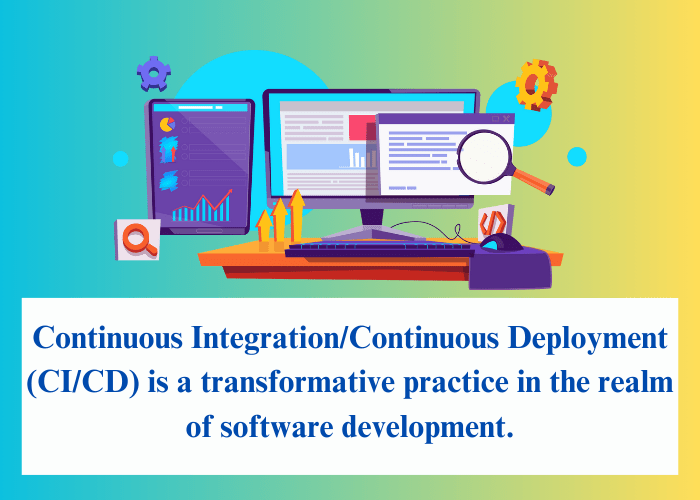
In the fast-paced landscape of software development, the principles of Continuous Integration (CI) and Continuous Deployment (CD) emerge as powerful paradigms. It revolutionizes the way applications are built, tested, and deployed.
This comprehensive article delves into the realm of CI/CD, unveiling its significance and methodologies. Additionally, it also throws light on why pursuing a dedicated full-stack development course is vital for mastering this cutting-edge practice.
Understanding the CI/CD Paradigm
What is CI/CD and why is it important? If we try to understand this topic in simple language then we can say that, Continuous Integration (CI) and Continuous Deployment (CD) are a set of software engineering practices. These practices emphasize on the frequent integration of code changes into a shared repository and the automated release of these changes to production environments. This approach has several benefits. It accelerates development cycles, enhances collaboration, and ensures the rapid and reliable delivery of software products.
Understanding the Dynamics of CI/CD
CI/CD involves using certain methods and tools together in order to make the process of creating software smoother. Here are the main parts of CI/CD:
- Continuous Integration
CI focuses on the frequent integration of code changes from multiple developers into a shared repository. Automated testing ensures that code changes do not break existing functionality. - Continuous Deployment
CD takes CI a step further by automating the deployment of code changes to production environments. This ensures that new features, bug fixes, and improvements are available to end-users as soon as they are ready. - Automated Testing
Automated testing is a cornerstone of CI/CD. It involves creating a suite of tests that run automatically whenever code changes are integrated. This guarantees that new changes do not introduce regressions or defects. - Version Control
Version control systems like Git play a pivotal role in CI/CD, allowing developers to manage code changes, collaborate effectively, and track the history of changes. - Deployment Pipelines
Deployment pipelines automate the process of building, testing, and deploying code changes. Pipelines consist of multiple stages that ensure code is thoroughly tested before it reaches production. - Monitoring and Feedback Loops
CI/CD emphasizes the importance of monitoring applications in production. Feedback loops allow developers to quickly identify issues and roll back changes if necessary.
The Significance of CI/CD in Modern Development
In the fast-evolving world of software development, CI/CD has become a fundamental practice. Here’s why CI/CD is crucial in modern development:
- Rapid Iteration
CI/CD allows for rapid iteration and delivery of software. Developers can push changes to production more frequently, ensuring that new features and improvements are available to users without delay. - Reduced Risk
Automated testing and deployment pipelines reduce the risk of human error, ensuring that code changes are thoroughly tested before reaching production. - Enhanced Collaboration
CI/CD promotes collaboration among developers by encouraging frequent code integration and sharing. This accelerates development cycles and leads to better code quality. - Agile Development
CI/CD aligns well with Agile development methodologies, enabling teams to respond quickly to changing requirements and deliver value to users consistently. - Faster Time-to-Market
By automating the deployment process, CI/CD accelerates the time it takes for code changes to reach production, enabling organizations to deliver new features and updates faster. - Improved Quality
Automated testing ensures that code changes meet quality standards, reducing the likelihood of defects reaching production environments. - Continuous Feedback
CI/CD emphasizes monitoring and feedback, enabling developers to quickly identify and address issues in production, leading to a better user experience.
Pursuing a Full-Stack Development Course: Your Gateway to CI/CD Proficiency
For aspiring full-stack developers, understanding CI/CD principles is essential to excel in the rapidly evolving landscape of software development. Enrolling in a full-stack development course equips learners with the skills and knowledge needed to harness the power of CI/CD effectively.
Here are several compelling reasons why pursuing a full-stack development course is beneficial:
- Holistic Learning
A well-structured full-stack development course covers a wide array of technologies, methodologies, and practices, ensuring a comprehensive understanding of modern development principles. - Practical Experience
Hands-on projects and assignments provide learners with practical experience, enabling them to apply theoretical concepts to real-world scenarios. - Industry Insights
Experienced instructors share insights into industry trends, best practices, and emerging technologies, keeping learners updated with the ever-evolving landscape of full-stack development. - Networking Opportunities
Participating in a full-stack development course connects learners with fellow enthusiasts, fostering collaboration and potential partnerships.
Choosing the Right Learning Hub

Pursuing a full-stack development course in Kurukshetra, Bangalore, Mumbai, Delhi, Noida, or Pune offers distinct advantages:
- Thriving Tech Ecosystem
These cities boast vibrant tech ecosystems, providing ample networking opportunities, hackathons, and tech meetups. - Industry Exposure
Tech-centric regions expose learners to cutting-edge technologies and real-world industry practices, ensuring their education remains relevant and applicable. - Access to Experts
Experienced professionals, tech leaders, and industry experts often contribute as guest lecturers, offering learners valuable insights and real-world perspectives. - Diverse Learning Formats
Tech hubs offer a variety of learning formats, from boot camps and online courses to workshops and seminars, catering to diverse learning preferences.
Conclusion
Continuous Integration/Continuous Deployment (CI/CD) is a transformative practice in the realm of software development. It streamlines development processes, accelerates time-to-market, and enhances collaboration among developers. Mastering CI/CD principles is a crucial skill for aspiring full-stack developers, and enrolling in a dedicated full-stack development course provides the knowledge and expertise needed to excel in this domain. As technology continues to advance, embracing CI/CD can position aspiring professionals for success in the dynamic and competitive world of software development.


